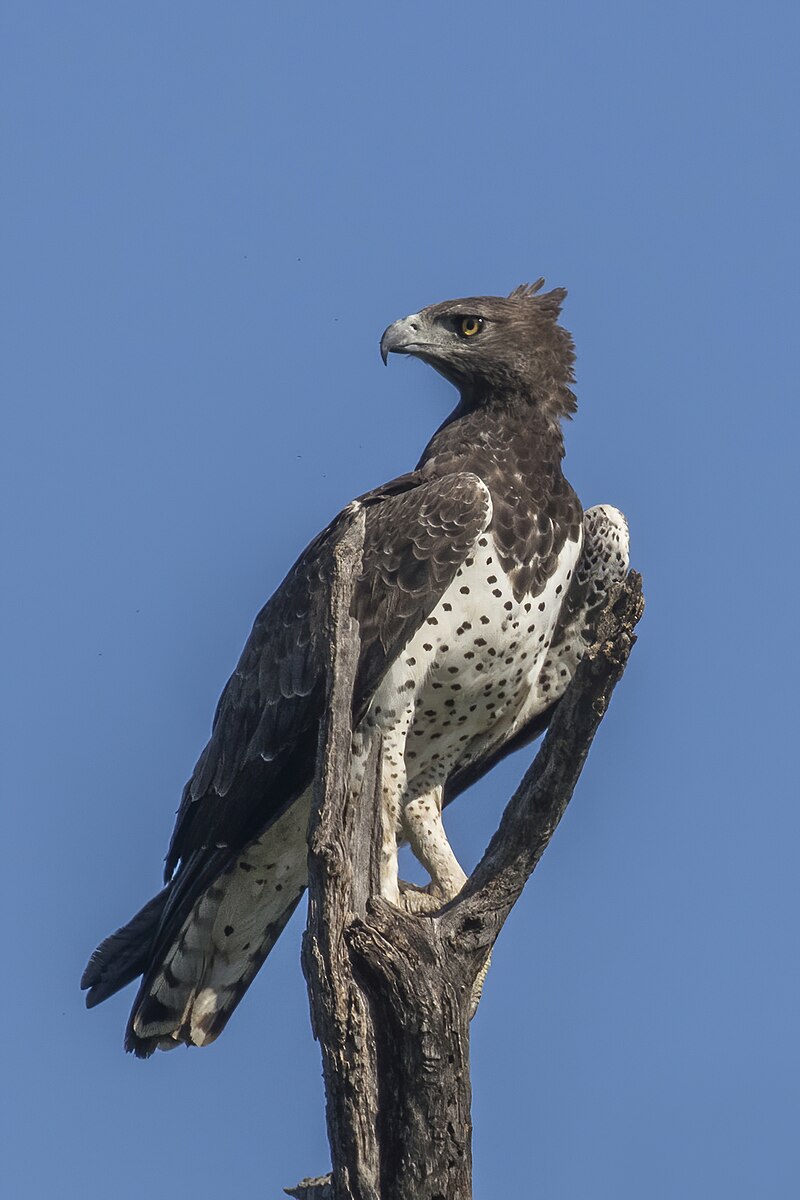The Martial Eagle (Polemaetus bellicosus) is a large, long-winged bird of prey that inhabits dry grassland, scrubland, and scattered woodland habitats of sub-Saharan Africa. It is one of the largest birds of prey in the world, and, with a length reaching up to 96 cm (37 inches) long and a weight up to 6.5 kg (14 pounds), it is the largest eagle in Africa. The Martial Eagle has a brown head, throat, and wings, with underparts that are white with dark spots, and the undersides of its tail feathers are striped with black.
The Martial Eagle: A Powerful Apex Predator
Martial eagles are often considered apex predators in the ecosystems they inhabit. They consume a wide variety of prey but mostly prefer birds and other medium-sized vertebrates, including poultry, smaller livestock (such as young goats), small antelopes and hyraxes, rabbits, snakes and lizards, and even monkeys. Martial eagles hunt from the air or from a high perch, and they can spot their prey from a distance of several kilometers before diving to attack. A diving martial eagle can descend at 230 km (143 miles) per hour, killing many of its prey upon impact.
Martial Eagle Breeding and Nesting Habits
 Image source: Martial eagle by Charles J. Sharp
Image source: Martial eagle by Charles J. Sharp
Martial eagles are monogamous birds that become sexually mature about age four. They construct large nests (which range from 1.2 to 1.8 meters [4 to 6 feet] in diameter) in tall trees or on electrical towers (power pylons) set between 6 and 24 meters (20 and 80 feet) above the ground. The nests are lined with leaves and sticks. Pairs of eagles build two nests typically, between which they alternate from one year to the next. Breeding may happen throughout the year, and the female usually lays one egg, which is incubated for about 45 days before the young bird hatches. Both parents feed and protect their chick for almost two months. Although the young bird makes its first flight some 90–100 days after hatching, it will not become fully independent until 2–3 years later.
Threats to the Martial Eagle
The International Union for Conservation of Nature and Natural Resources (IUCN) considered the martial eagle as a species of least concern in 2008; however, owing to precipitous declines in the bird’s population, the IUCN has listed it as an endangered species since 2020. Martial eagles are often hunted, trapped, and poisoned by commercial farming operations to keep the birds from attacking a wide range of domesticated birds and other livestock, and these activities are largely responsible for the species’ plunging numbers. Lesser threats include habitat loss and degradation from pollution, increases in mortality among the young due to nest disturbances, and decreases in food due to population declines among its prey.
The Martial Eagle’s Counterpart: The African Crowned Eagle
The African Crowned Eagle (Stephanoaetus coronatus) is another large and powerful eagle found in sub-Saharan Africa. While not as massive as the Martial Eagle, the African Crowned Eagle is still an impressive bird, with a length of up to 90 cm (35 inches) and a weight of up to 5.5 kg (12 pounds). This eagle is known for its distinctive crest and its ability to hunt and kill relatively large prey, including small antelope, monkeys, and even small children.
Conservation Efforts for the Martial Eagle
The Peregrine Fund has been working in Kenya for decades, striving to conserve the birds of prey found there and their habitats. The Martial Eagle is found throughout much of sub-Saharan Africa and can be found in over 40 countries in this region. Conservation efforts are crucial to protect this majestic eagle and its habitat, as it faces numerous threats, including habitat loss, poisoning, and human persecution.
In conclusion, the Martial Eagle is a remarkable bird of prey that plays a vital role in the ecosystems of sub-Saharan Africa. While it faces significant challenges, conservation efforts are underway to protect this magnificent species and its habitat. By understanding the unique characteristics and threats facing the Martial Eagle, we can work to ensure its survival for generations to come.
References:
– African Crowned Eagle v Martial Eagle – Page 2 – Carnivora. (n.d.). Retrieved from https://carnivora.net/african-crowned-eagle-v-martial-eagle-t3558-s15.html
– Martial eagle | Description, Prey, Conservation Status, & Facts. (2024-03-07). Retrieved from https://www.britannica.com/animal/martial-eagle
– Martial Eagle | The Peregrine Fund. (n.d.). Retrieved from https://peregrinefund.org/explore-raptors-species/eagles/martial-eagle
– Martial Eagle – Largest African Eagle – Kruger National Park. (n.d.). Retrieved from https://www.krugerpark.co.za/africa_martial_eagle.html

